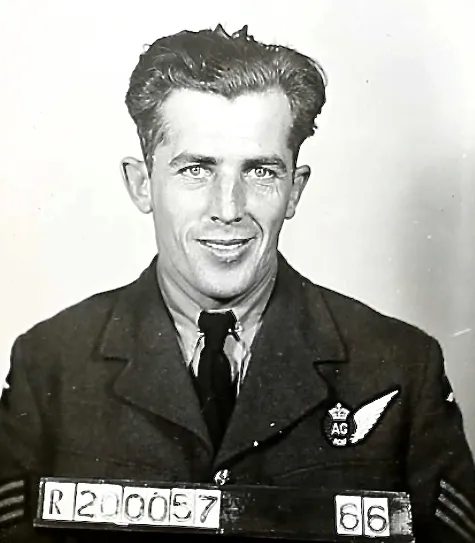Tuuri, Albert William
Killed in Action 1944-07-28


Birth Date: 1913-October-10
Born:
Son of Easias Emil and Maria Eleanora Tuuri. Brother of Harold Edgar Tuuri who died on February 25, 1945 while serving with the Lake Superior Regiment (Motor).
Home: Pearl, Ontario
Enlistment:
Enlistment Date: Unknown
Service
RCAF
Unit
101 Sqn- Squadron (RAF)
Mens Agitat Molem Mind over matter
Base
Rank
Pilot Officer
Position
Pilot Officer
Service Numbers
J/95438
Prev: R/200057
Home
 Pearl, Ontario
Pearl, Ontario
Target
 Stuttgart Germany
Stuttgart Germany
First Burial
 Communal Cemetery At Rebrechien, Loiret, France
Communal Cemetery At Rebrechien, Loiret, France
Avro Lancaster

Canadian Warplane Heritage Museum
The Avro Lancaster is a British Second World War heavy bomber. It was designed and manufactured by Avro as a contemporary of the Handley Page Halifax, both bombers having been developed to the same specification, as well as the Short Stirling, all three aircraft being four-engined heavy bombers adopted by the Royal Air Force (RAF) during the same wartime era.
The Lancaster has its origins in the twin-engine Avro Manchester which had been developed during the late 1930s in response to the Air Ministry Specification P.13/36 for a capable medium bomber for "world-wide use". Originally developed as an evolution of the Manchester (which had proved troublesome in service and was retired in 1942), the Lancaster was designed by Roy Chadwick and powered by four Rolls-Royce Merlins and in one version, Bristol Hercules engines. It first saw service with RAF Bomber Command in 1942 and as the strategic bombing offensive over Europe gathered momentum, it was the main aircraft for the night-time bombing campaigns that followed. As increasing numbers of the type were produced, it became the principal heavy bomber used by the RAF, the Royal Canadian Air Force (RCAF) and squadrons from other Commonwealth and European countries serving within the RAF, overshadowing the Halifax and Stirling. Wikipedia
101 Sqn Mens Agitat Molem ()
No. 101 Squadron RAF was originally formed within the RFC as a bomber unit in July 1917. It was disbanded in December 1919, then re-formed at Bircham Newton, Norfolk, in 1928, being the only operational squadron to fly the Boulton Paul Sidestrand and Overstrand aircraft. These were the first RAF bombers to have enclosed and power-operated turrets. When WWII broke out, the squadron was based at West Raynham, Norfolk, having now equipped with Bristol Blenheim aircraft. It was a reserve squadron until its first operation against Germany in July, 1940, and it later spent the greater part of its attacks on the barges in the channel and North Sea ports, which had been gathered for operation SEALION, the projected German invasion of Britain. In April 1941, a flight of the squadron's Blenheims was detached to Manston in Fighter Command's No. 11 Group, and from there it attacked enemy shipping during daylight, in an operation known as Channel Stop. In June, 1940 the squadron moved to Oakington, Cambridgeshire, where it remained until February 1942, when it moved to Bourne, Cambridgeshire.
During May and June 1941, the squadron converted to Vickers Wellingtons and flew with Bomber Command. It participated in all three 1000-bomber raids to Cologne, Essen and Bremen in 1942. In August 1942 the squadron moved to Stradishall, Suffolk, and in September to Holme-on-Spalding Moor, Yorkshire. Later in the year the squadron converted to Avro Lancaster aircraft, and continued the Bomber Command assault on Germany and Italy. In June 1943 the squadron moved again, to Ludford Magna, Lincolnshire. It participated in the raid on the rocket development centre at Peenemunde, and was fortunate enough to evade the enemy night fighters on that occasion.
In late 1943 the squadron was given a new function within Bomber Command, that of Radio Counter Measures, to attempt to cut the radio communications between the German night fighter controllers and the fighter pilots. Each aircraft was equipped with the radio device known as A.B.C. or Airborne Cigar. A special German-speaking radio operator in the aircraft used the ABC equipment to scan the appropriate frequencies, and when the German signals were detected, jamming was started by transmitting a warbling note. The Lancaster aircraft carrying ABC were easily distinguished because they carried three large aerials, two dorsally and one under the nose. In addition to the ABC equipment, the Lancasters carried a full bomb load. Unfortunately, because they transmitted strong signals, it was possible for night fighters to seek them out, and squadron losses were relatively high as a consequence; only three other Lancaster squadrons had higher losses. On the night of 5/6 June 1944, the squadron put up 21 ABC Lancasters to jam enemy wireless communications to prevent night fighters from being directed to the airborne invasion forces.
After its last operational mission, to Berchtesgaden in late April 1945, the squadron participated in operation MANNA, dropping food to help the staving populace of the Netherlands. It also was part of operation DODGE, bringing back British troops from Italy. The squadron moved to Binbrook, Lincolnshire in October 1945. It was successively equipped with Avro Lincoln, English Electric Canberra and Avro Vulcan aircraft.
 Canadian Virtual War Memorial
Canadian Virtual War Memorial Commonwealth War Graves Commission
Commonwealth War Graves Commission www.findagrave.com
www.findagrave.com Lancaster Bomber
Lancaster Bomber Wikipedia
Wikipedia Harold A Skaarup Web Page
Harold A Skaarup Web Page